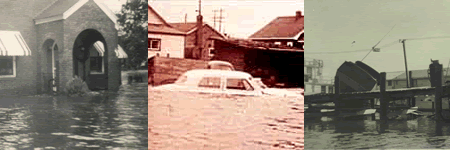
|
|

The Ocean Ranger Storm in 1982 was more intense (winds near 170 km/h). The August Hurricane of 1927 claimed more lives (at least 173). The Ice Storm of 1998 affected more people (over a million households lost power). The Edmonton tornado in 1987 was more sudden (less than an hour warning). Yet, no weather disaster has fixed itself more firmly in Canadian folklore than Hurricane Hazel’s impact on Southern Ontario.
Hurricane Hazel struck Toronto on October 15, 1954, killing 81 people and leaving 1,896 families homeless. The record rainfall that the storm brought to Toronto—up to 225 mm—was unable to infiltrate the ground because the above-average rainfall in the preceding month had already filled the water table. Most of the rain simply ran off the surface into rivers and creeks, rapidly filling them to capacity and beyond. One estimate of runoff was that 90% of the precipitation ran off the land directly into rivers raising the water level by 6–8 metres. Water coursed through creeks where they had never before existed, derailed trains and washed out roads. Rampaging rivers tore houses from their foundations, picked up cars and mobile homes, and wrecked boats.
The Humber River Valley was the hardest hit. The bottom end of Raymore Drive was levelled killing 35 people. Farther downstream on the Humber, five firemen who were dispatched to rescue people trapped in their car by floodwaters were killed. The Holland Marsh, located north of Toronto, was turned into a lake, ruining houses and crops and forcing residents to flee. The marsh was pumped dry over several weeks before the levels of the dykes surrounding the marsh were raised and the drainage ditches deepened. The community of Long Branch, on the shores of Lake Ontario where Etobicoke Creek enters the lake, was also severely flooded and would be evacuated and eventually turned into a park. Damage was not isolated to these communities, but was felt throughout Southern Ontario as far away as Ottawa.
Recovery began immediately after the waters receded, with the aid of the militia, who searched the river valleys for flood victims, and relief organizations such as the Red Cross and Salvation Army. Relief organizations rushed to set up temporary shelters, find long term housing for displaced people, collect food and clothing, and raise funds. The Hurricane Relief Fund was created to collect money from people around the city, province, and world, and distribute funds to victims of the flood. The estimated cost of Hazel by a Royal Commission studying the effects was placed at $100,000,000, which in 2004 would be approximately $1 billion.
How government organizations handled the disaster was evaluated following Hazel. The weather office was both praised for their accuracy and emphatic warnings and denounced for not providing enough warning. The outcome of Hurricane Hazel was the recognition of the flood hazard in Southern Ontario and the development of plans to cope with the risk. Civil defence offices were created and trained with monies provided by the municipal, federal and provincial governments, conservation authorities were allowed more power to protect vulnerable land, and parklands were formed around the city.
Another significant outcome of Hazel was the formation of Toronto and Region Conservation (TRCA) and the prioritization of flood control and flood warnings by the three levels of government. Conservation authorities were granted powers to buy and regulate floodplain land and, in cooperation between the three levels of government, helped create flood control and flood warning systems. Floodplains were bought from private property owners and returned to the river and land-development was restricted. The debate on dams was reopened following Hazel and again when the TRCA presented their Plan for Flood Control and Water Conservation, which would only be partially completed.
If another storm were to follow the exact path and strength of Hazel, the city is now better prepared to cope: yet, the risk has not been abolished. Developments remain in the city’s floodplains and there is a lack of awareness of the risk; as 50 years have passed, local area residents’ memory of the storm has faded.
|
